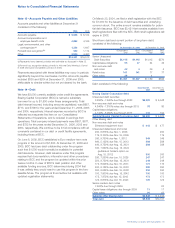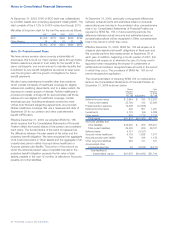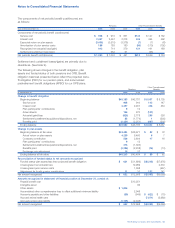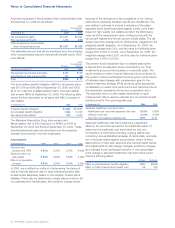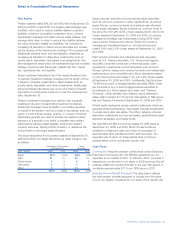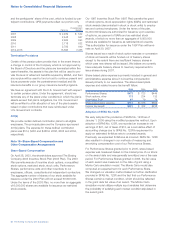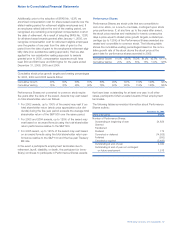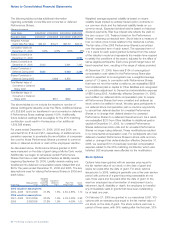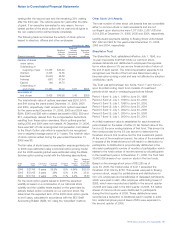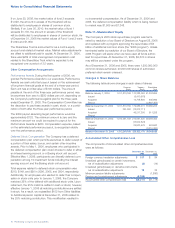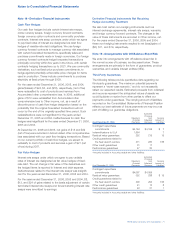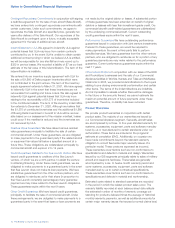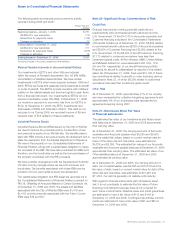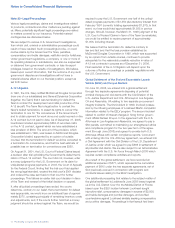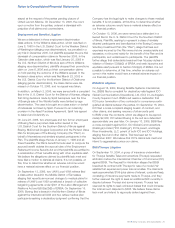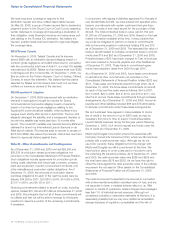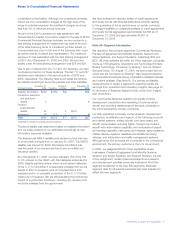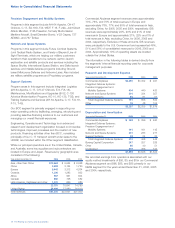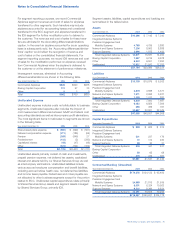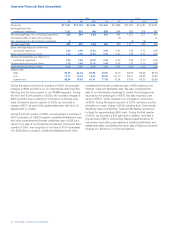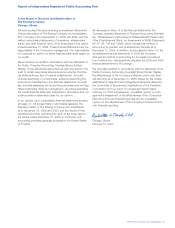Boeing 2006 Annual Report Download - page 73
Download and view the complete annual report
Please find page 73 of the 2006 Boeing annual report below. You can navigate through the pages in the report by either clicking on the pages listed below, or by using the keyword search tool below to find specific information within the annual report.
The Boeing Company and Subsidiaries 71
Notes to Consolidated Financial Statements
Note 18 – Derivative Financial Instruments
Cash Flow Hedges
Our cash flow hedges include certain interest rate swaps,
cross currency swaps, foreign currency forward contracts,
foreign currency option contracts and commodity purchase
contracts. Interest rate swap contracts under which we agree
to pay fixed rates of interest are designated as cash flow
hedges of variable-rate debt obligations. We use foreign
currency forward contracts to manage currency risk associated
with certain forecasted transactions, specifically sales and
purchase commitments made in foreign currencies. Our foreign
currency forward contracts hedge forecasted transactions
principally occurring within five years in the future, with certain
contracts hedging transactions up to 2021. We use commodity
derivatives, such as fixed-price purchase commitments, to
hedge against potentially unfavorable price changes for items
used in production. These include commitments to purchase
electricity at fixed prices through 2009.
For the years ended December 31, 2006, 2005, and 2004,
gains/(losses) of $24, $3, and ($16), respectively, (net of tax)
were reclassified to cost of products and services from
Accumulated other comprehensive loss. In 2006, additional
gains of $12 were reclassified from Accumulated other
comprehensive loss to Other income, net, as a result of
discontinuance of cash flow hedge designation based on the
probability that the original forecasted transactions will not
occur by the end of the originally specified time period. Such
reclassifications were not significant for the years ended
December 31, 2005 and 2004. Ineffectiveness for cash flow
hedges was insignificant for the years ended December 31, 2006,
2005 and 2004.
At December 31, 2006 and 2005, net gains of $18 and $32
(net of tax) were recorded in Accumulated other comprehensive
loss associated with our cash flow hedging transactions. Based
on our current portfolio of cash flow hedges, we expect to
reclassify to cost of products and services a gain of $21 (net
of tax) during 2007.
Fair Value Hedges
Interest rate swaps under which we agree to pay variable
rates of interest are designated as fair value hedges of fixed-
rate debt. The net change in fair value of the derivatives and
the hedged items is reported in Interest and debt expense.
Ineffectiveness related to the interest rate swaps was insignifi-
cant for the years ended December 31, 2006, 2005 and 2004.
For the years ended December 31, 2006, 2005 and 2004, $8,
$12, and $24 of gains related to the basis adjustment of certain
terminated interest rate swaps and forward-starting interest rate
swaps were amortized to earnings.
Derivative Financial Instruments Not Receiving
Hedge Accounting Treatment
We also hold certain non-hedging instruments such as
interest exchange agreements, interest rate swaps, warrants,
and foreign currency forward contracts. The changes in fair
value of these instruments are recorded in Other income, net.
For the years ended December 31, 2006, 2005 and 2004,
these non-hedging instruments resulted in net (loss)/gains of
($6), $11, and $19, respectively.
Note 19 – Arrangements with Off-Balance Sheet Risk
We enter into arrangements with off-balance sheet risk in
the normal course of business, as discussed below. These
arrangements are primarily in the form of guarantees, product
warranties, and variable interest entities (VIEs).
Third-Party Guarantees
The following tables provide quantitative data regarding our
third-party guarantees. The maximum potential payments
represent a “worst-case scenario,” and do not necessarily
reflect our expected results. Estimated proceeds from collateral
and recourse represent the anticipated values of assets we
could liquidate or receive from other parties to offset our
payments under guarantees. The carrying amount of liabilities
recorded on the Consolidated Statements of Financial Position
reflects our best estimate of future payments we may incur as
part of fulfilling our guarantee obligations.
Estimated
Proceeds
Maximum from Carrying
Potential Collateral/ Amount of
As of December 31, 2006 Payments Recourse Liabilities*
Contingent repurchase
commitments $4,164 $4,155 $««««7
Indemnifications to ULA 1,664 7
Residual value guarantees 252 215 15
Credit guarantees related to
the Sea Launch venture 471 283 188
Other credit guarantees 31 17
Performance guarantees 47 20
*Amounts included in Accounts payable and other liabilities
Estimated
Proceeds
Maximum from Carrying
Potential Collateral/ Amount of
As of December 31, 2005 Payments Recourse Liabilities*
Contingent repurchase
commitments $4,067 $4,059
Residual value guarantees 352 288 $««15
Credit guarantees related to
the Sea Launch venture 490 294 196
Other credit guarantees 41 13 8
Performance guarantees 48 21 1
*Amounts included in Accounts payable and other liabilities


